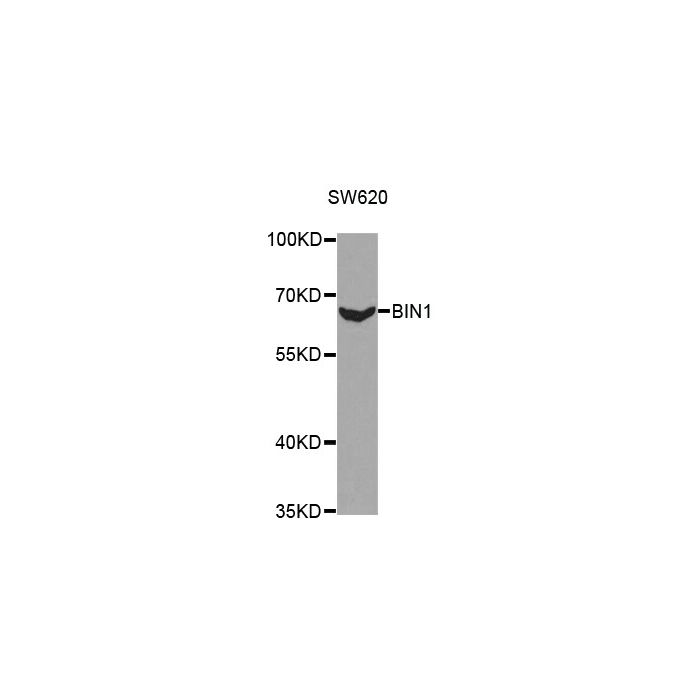BIN1 polyclonal, anti-human, mouse, rat
€388.00
In stock
SKU
BS7684
Background:
This gene encodes several isoforms of a nucleocytoplasmic adaptor protein, one of which was initially identified as a MYC-interacting protein with features of a tumor suppressor. Isoforms that are expressed in the central nervous system may be involved in synaptic vesicle endocytosis and may interact with dynamin, synaptojanin, endophilin, and clathrin. Isoforms that are expressed in muscle and ubiquitously expressed isoforms localize to the cytoplasm and nucleus and activate a caspase-independent apoptotic process. Studies in mouse suggest that this gene plays an important role in cardiac muscle development. Alternate splicing of the gene results in ten transcript variants encoding different isoforms. Aberrant splice variants expressed in tumor cell lines have also been described. [provided by RefSeq, Sep 2011]
Alternative Name:
AMPH 2, AMPH2, Amphiphysin 2, Amphiphysin II, Amphiphysin like protein, amphiphysin-like, Amphiphysin-like protein, AMPHL, Bin1, BIN1_HUMAN, Box Dependant MYC Interacting Protein 1, Box-dependent myc-interacting protein 1, Bridging integrator 1, DKFZp547F068, MGC10367, MGC105358, Myc box dependent interacting protein 1, Myc box-dependent-interacting protein 1, SH3P9,
Application Dilution: WB: 1:500~1:2000, IHC/IF: 1:50~1:200
Specificity: BIN1 polyclonal antibody detects endogenous levels of BIN1 protein.
Immunogen:
Recombinant full length Human BIN1.
MW: ~ 65 kDa
Swis Prot.: O00499
Purification & Purity:
The antibody was affinity-purified from rabbit antiserum by affinity-chromatography using epitope-specific immunogen and the purity is > 95% (by SDS-PAGE).
Format:
1mg/ml in PBS with 0.1% Sodium Azide, 50% Glycerol.
Storage:
Store at 4°C short term. Aliquot and store at -20°C long term. Avoid freeze-thaw cycles.
For research use only, not for use in diagnostic procedure.
This gene encodes several isoforms of a nucleocytoplasmic adaptor protein, one of which was initially identified as a MYC-interacting protein with features of a tumor suppressor. Isoforms that are expressed in the central nervous system may be involved in synaptic vesicle endocytosis and may interact with dynamin, synaptojanin, endophilin, and clathrin. Isoforms that are expressed in muscle and ubiquitously expressed isoforms localize to the cytoplasm and nucleus and activate a caspase-independent apoptotic process. Studies in mouse suggest that this gene plays an important role in cardiac muscle development. Alternate splicing of the gene results in ten transcript variants encoding different isoforms. Aberrant splice variants expressed in tumor cell lines have also been described. [provided by RefSeq, Sep 2011]
Alternative Name:
AMPH 2, AMPH2, Amphiphysin 2, Amphiphysin II, Amphiphysin like protein, amphiphysin-like, Amphiphysin-like protein, AMPHL, Bin1, BIN1_HUMAN, Box Dependant MYC Interacting Protein 1, Box-dependent myc-interacting protein 1, Bridging integrator 1, DKFZp547F068, MGC10367, MGC105358, Myc box dependent interacting protein 1, Myc box-dependent-interacting protein 1, SH3P9,
Application Dilution: WB: 1:500~1:2000, IHC/IF: 1:50~1:200
Specificity: BIN1 polyclonal antibody detects endogenous levels of BIN1 protein.
Immunogen:
Recombinant full length Human BIN1.
MW: ~ 65 kDa
Swis Prot.: O00499
Purification & Purity:
The antibody was affinity-purified from rabbit antiserum by affinity-chromatography using epitope-specific immunogen and the purity is > 95% (by SDS-PAGE).
Format:
1mg/ml in PBS with 0.1% Sodium Azide, 50% Glycerol.
Storage:
Store at 4°C short term. Aliquot and store at -20°C long term. Avoid freeze-thaw cycles.
For research use only, not for use in diagnostic procedure.
| Is Featured? | No |
|---|
Write Your Own Review

